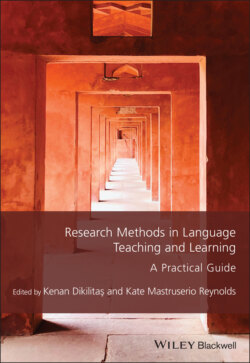Читать книгу Research Methods in Language Teaching and Learning - Группа авторов - Страница 39
The Diarists and the Data
ОглавлениеAs with any diary-based research, the participants in my study inevitably responded to the process of maintaining their diary in differing ways, with implications for the subsequent analysis of data. As noted in the previous section, I needed to be aware of recruitment bias during participant selection, taking account of, for example, the ways in which the diarists’ age, gender, class, and cultural background might affect their engagement with the research and with diary-writing. The cohort of learners were relatively homogeneous in terms of age and cultural background (see “Finding Participants” above), and it seems reasonable to assume that, as they had all traveled to the UK to study in a private language school, there was perhaps a degree of similarity in their social or material resource backgrounds. However, over the course of the study, some variation emerged in their attitudes towards the self-narration and self-disclosure that ethnographic diaries require. Typical of similar studies, some were more comfortable with the idea and identity of “being a writer” than others (Elliott, 1997), and thus the diarists differed in what they were willing and able to articulate, and how far they were prepared to do this in the diaries’ written format (Hall, 2008). This had implications for the length and comprehensiveness of data that different diarists contributed to the research, and, consequently, for the extent to which any particular individual’s “voice” emerged during the analysis of the diary data. This was not unexpected, however, and any unevenness in participant voice in the diaries was to a large extent ameliorated by the triangulation of different data sets (e.g., the project’s interviews), these differing modes of expression enabling those reluctant to engage in writing, or who required further prompting in order to report their experience and perceptions, to do so more fully.
Meanwhile, some of the study’s participants recorded their experiences and perspectives as soon as their lessons had finished, some noted them some time later on the same day, and some documented them the following day. Typical of many diary studies, this variation had potential implications for recall and participants’ emotional engagement with what they discussed. Hall (2008), for example, outlines how, following a particularly negative diary entry, a participant clarified in a later commentary that they no longer felt that way about the event described. Although during data analysis, I needed to proceed on the basis that participants told the truth, or what they saw as the truth at the time of writing (ibid.), there was the possibility that the diarists might, whether deliberately or not, have misled, evaded, lied or “put up fronts” (Fine, 1993, p. 271). Overall, therefore, my diary data needed to be treated with a degree of caution or even “suspicion” (ibid.).
It also seemed possible that the actual act of reflecting on and recording experiences through a diary may have caused participant “reactance” (Bolger et al., 2003), that is, changed their behavior, experience, or ways of thinking. For Bolger et al. (ibid.), the overall impact of reactance on the validity of diary data is likely to be relatively limited as initial changes in behavior fade over time, with diarists becoming increasingly used to their role as research participants through a process of “habituation.” That said, many learners in my diary study experienced changes in the way they experienced and perceived group work, while, for some, the act of reflecting brought the unconscious into consciousness, and/or led to the development of more complex understandings of classroom life (see also, Hall, 2008, pp. 116–117), echoing Elliott’s (1997) report of participants’ diary entries becoming more reflective over the course of her study.
Consequently, when analyzing the diary data, I had to some extent to “distrust” it. This involved the recognition that the data was partial; it was at times contradictory and recorded participants’ many and multiple “truths”; it included elements that were irrelevant to the study’s aims; and some diarists’ voices appeared within it more strongly than others’. Yet in the context of an ethnographic study, this variation within and between data was not a weakness – similar data does not necessarily equate to reliability when dealing with participants’ insider understandings of their own experiences (see also Mackrill, 2008). All research, even that claiming to be “scientific,” is “context bound and speak[s] to certain people, times and circumstances” (Plummer, 1983, p. 14).
Thus, what was important for my study, as with all projects, was that the processes of data analysis and interpretation were transparent, that is, that I was clear about the reasons for the decisions I made about data collection and analysis, and their implications (as outlined in this chapter). Furthermore, it was also important to make this explicit when the findings of the project were disseminated through presentation and publication. Indeed, the key paper resulting from this project, Hall (2008), focuses only on such methodological issues.
